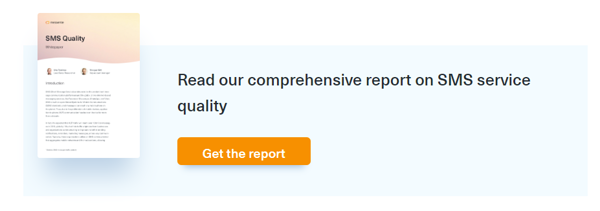SMS throughput is the measure of data transfer between the connections measured by message per second. So, sending a message per second means 3600 messages per hour. The higher the throughput the more messages you can send in a timely manner.
What is SMS throughput?
The higher the throughput, the more texts you can send out to customers.
Want to know more? Here's everything you need to know about SMS API providers!
Most mobile messaging services limit the number of texts your company can send per second in order to comply with industry standards. Additionally, this limitation prevents their systems from being overwhelmed.
Sending an excessive number of texts within a small time frame can cause a bottleneck, a place where SMS messages fail to send (or get delayed). This bottleneck occurs on the mobile service provider's end when they can't keep up with the sheer amount of texts you are attempting to send.
This can be overcome by utilizing an alternative connection or by prioritizing the SMS.
Alternative connections
Many cell phone service providers have to place limitations on their infrastructure. This may mean that your goal of messaging 15,000 of your new annual customers about a sale is restricted and delayed.
Limitations are the best way for cell phone providers to handle the wave of incoming texts but what does it mean for your business?
It means your messages will be clogged in a pipeline of other texts, slowly dispersed over a period of time until the bottleneck is cleared.
This is not ideal for businesses striving for great customer service or strong marketing campaigns. Your campaign can be stopped in its tracks to allow the mobile service to catch up to the demand.
Industry standards can handle 10 - 30 messages per second for every connection. In the grand scheme of things, this is a minuscule number and one to be conscious of when designing an SMS marketing campaign. The last thing we want is for your perfectly planned campaign to be stopped at the first hurdle, leaving customers with delayed texts in a jumbled order. Using an alternative route is the answer to bulk SMS problems.
Using an alternative route
Break free from the limitations of using one connection to reach your customers and use a combination to reach your SMS outreach potential.
SMS API solutions can manage more SMS messages by using operator connections and alternative routes.
What is an alternative route?
A route is a connection to your customer's phone via an operator or carrier. We use these routes to get your message to your customer's mobile service provider, then they send the SMS to the customer's phone.
An alternative route is one that uses a slightly different pathway to standard options which can result in your messages arriving faster and in greater numbers, especially during peak times. At Messente use smart algorithms and adaptive routing to determine the fastest way to get your message to your customer.
Using an alternative route can allow you to send more messages per second resulting in a higher throughput rate.
Having a standard throughput of 20 SMS per second results in your business sending 72000 messages an hour to customers, which is suitable for businesses smaller in size. Large scale companies and operations like emergency services must reach more people, requiring an alternative connection to send more texts per second.
Higher throughput enables service providers to deliver timely messages even during peak times when thousands of messages are delivered every minute. This means that they can handle multiple accounts sending high volumes of messages without delay. This is crucial when sending timely notifications, emergency alerts, PIN codes or reminders.
While having one’s own connections to operators is a possibility, it is rare that anyone other than an SMS service provider can get a much higher throughput as well as have their messages classified as a priority (more on that to follow).
So, anything over that throughput limit will get stuck and if the prioritization is flat, sending out a large marketing campaign can stall any other time-critical message that needs to go through. This can result in undelivered messages, delays or loss of message content in multipart messages.
What is SMS priority?
Consider a priority SMS to be just that: a high priority text message.
Examples of priority SMS include one time passwords, reminders or emergency updates. A priority SMS is a vital piece of information so you can imagine the consequences of failing to deliver a priority text to a customer due to peak times or a bottleneck.
To ensure that critical messages are delivered on time, SMS service providers like Messente have implemented systems to ensure the vital texts are sent first.
This is done via a prioritization system. Our system will send priority texts during peak times that might exceed the maximum throughput limit. These texts will be sent out before marketing messages.
When it comes to priority texts, we are talking in terms of seconds rather than minutes, hours or days.
Both low priority and high priority texts come before marketing campaigns and will still arrive within a matter of seconds.
High priority texts like confirmation codes will be sent the fastest, usually within a second. A confirmation code falls under high priority as any delay could cause the customer to resubmit a request for another code if they think the system is slow, this could double the expense for your business.
The beauty of prioritization systems is that they allow businesses to be good at all aspects of customer communication. You can send out a large-scale marketing campaign and not worry about vital pin codes or updates as these will arrive at your customer's phone first.
Throughput and SMS priority at Messente
To reach every operator in the world, here at Messente, we work with different partners who can provide connections when operator connections are not possible.
We have more than 30 different ways of sending a text to an operator, multiplying the traffic we can send exponentially, guaranteeing that every message reaches the recipient in optimal time.
Do your research
When choosing an SMS service provider for your business, consider how quickly your messages need to be delivered and the throughput of your service provider. By doing your research, you’ll ensure that your business can connect with people without problems and take full advantage of bulk SMS campaigns.





